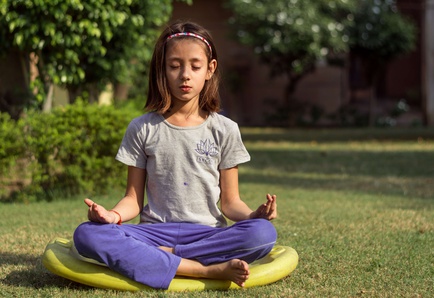Pauline Valdairon est sophrologue et praticienne en EFT. Grâce à son expérience sur le terrain, elle a pu nous guider, grâce à cet article, à la compréhension de cette pratique holistique qui permet un lâcher prise et une reconnexion à soi.
« Bonjour Pauline,
Je suis ravie de t’accueillir pour cet interview spécialisée sur la sophrologie. Aujourd’hui, tu en as fait ton métier. Tu rayonnes totalement par cette technique, pourrais-tu nous expliquer et approfondir nos connaissances sur le sujet ? »

Qu’est-ce que la sophrologie ? D’où nous vient cette technique ?
Créée en 1960 par le neuropsychiatre Alfonso Caycedo, la sophrologie est «l’étude de l’harmonie de la conscience ». C’est une méthode psycho-corporelle qui vise à favoriser l’harmonie entre le corps et l’esprit. Elle est une pratique de développement personnel utilisé comme technique thérapeutique ou comme philosophie de vie.
Alfonso caycedo cherchait une approche plus douce et plus efficace de soigner ses patients. Il développa alors une approche pour améliorer le bien-être. Il s’est ainsi inspiré de méthodes occidentales déjà connues et prouvées telles que l‘hypnose, le training autogène de Schultz, la relaxation de Jacobson ou encore la suggestion positive de la méthode Coué mais également des techniques asiatiques millénaires.
En effet à la suite d’un long voyage initiatique en Asie, en Inde, au Tibet et au Japon, le fondateur de la sophrologie s’est formé à des techniques comme le yoga, la méditation, le bouddhisme, le zen et s’en est inspiré pour enrichir sa méthode.
C’est riche de ce mélange qu’Alfonso Caycedo élabore toutes les techniques spécifiques en sophrologie.

Peut-on dire qu’il s’agit de méditation ou d’hypnose ?
Souvent opposées l’une à l’autre, la sophrologie et l’hypnose ont pourtant beaucoup en commun. En effet, ces deux approches profitent d’un état de conscience modifiée par une relaxation et une induction en proposant des visualisations ou des projections de changements. Ce qui diffère dans les techniques, c’est l ‘état de conscience guidée: En sophrologie nous nous adressons au conscient alors qu’en hypnose, l’idée est de parler à l’inconscient.
La méditation quant à elle est une pratique qui a aussi inspiré la sophrologie. Elle permet de se détacher de toutes distractions ou préoccupations mentales. C’est un entraînement sans aucune attente ou objectif particulier à atteindre, où chaque pratiquant progresse à son rythme, luttant contre ses propres écarts d’attention pour revenir systématiquement à l’écoute attentive de son corps ou de sa respiration. Dans un premier temps, il est tout à fait possible de suivre des méditations guidées et poursuivre son propre cheminement personnel de manière autonome.
Les différences entre ces pratiques sont subtiles ; l’hypnose comme la méditation ont inspiré la sophrologie, c’est donc très naturellement que chaque méthode a sa place dans cette technique. Il est à mon sens, beaucoup plus riche de s’intéresser à ce que peut apporter chaque support de manière complémentaire à une personne ou une autre en demande de son changement.
Qui peut suivre des séances de sophrologie ?
La sophrologie s’adresse à tous. Bien que le sujet soit véritablement conscient généralement à partir de 4 ans, la première indication est la motivation de l’intéressé.

Qui ne pouvons-nous pas accompagner avec la sophrologie ? Pourquoi
Il n’existe pas véritablement de contre-indications. Il est cependant important d’avoir conscience que la sophrologie ne remplace aucun traitement thérapeutique mais peu en augmenter l’efficacité. En revanche, des précautions doivent être prises pour des problèmes cardio-vasculaire, incompatibilité en positon debout, etc.
La pratique devra être adaptée aux personnes souffrants de troubles psychiatriques et deviendra une contre-indication totale dans des phases délirantes ou des sujets psychotiques chroniques qui risquerait avec la pratique, d’augmenter leur tendance à se déconnecter de la réalité et donc d’augmenter les troubles. (schizophrénie et psychose)
Comment se passe une séance ?
La première séance est l’occasion d’une approche. Elle consiste à un échange qui a pour but de déterminer l’état mental, physique et émotionnel de son client. Cela permet au sophrologue d’adapter son protocole en fonction des besoins et objectifs de chacun. On parle d’anamnèse, une étape indispensable pour mettre en place l’accompagnement de suivis afin que tout prenne une juste place dans l’esprit de chacun.
Ensuite, les séances de suivis débutent par un temps d’échange qui permet de déterminer l’état actuel de son client et d’orienter la séance en fonction.
De plus, le praticien invite à une pratique de la respiration puis de relaxation dynamique (détente physique) basé sur un travail de respiration lié à la tension et au relâchement de toute tensions corporelles.
A cela, vient s’ajouter une phase de relaxation statique appelé sophronisation ; phase où le sophronisé se laisse guider par la voix du sophrologue qui l’amène dans un état de conscience entre veille et sommeil (détente du cerveau et du mental). C’est dans cette phase de sophro-liminal que l’on travaille l’objectif de chacun selon ses attentes et ses besoins.
La fin de séance s’achève avec un moment d’échange sur les ressentis et les prises de conscience de la séance.
Le sophronisé reçoit des consignes à chaque séance afin de continuer à expérimenter et s’entraîner en vue de développer son autonomie à la pratique entre deux séances. Personnellement je propose toujours à mes clients d’enregistrer les séances sur leur téléphone afin de revenir sur la séance passée.
Combien de séances sont nécessaire pour aller mieux ?
La sophrologie est efficace immédiatement, c’est à dire que le sophronisé ressent les bienfaits durant la séance. Bien-sûr, comme tout travail sur soi, pour toute problématique ou symptôme, la sophrologie ne va pas amener à régler ce trouble en une seule séance malgré l’apaisement certain.
Même si elle fait partie des thérapies brèves, la sophrologie demande une pratique régulière pour être intégrée. Aussi, l’accompagnement permettra d’atténuer nettement les symptômes du troubles afin d’atteindre l’objectif de chacun. C’est dans ce sens qu’habituellement il faut compter entre 6 et 12 séances environ, en prenant compte que chaque personne est unique et évolue à son rythme.
Selon moi, il est bien de laisser une semaine entre deux séances cela permet d’intégrer et digérer les exercices. Je propose dans un premier temps des accompagnements hebdomadaire sur six semaines, puis je propose à nouveau, selon le rythme de chacun, d’étirer l’espace entre deux séances à deux semaines afin de garder une bonne dynamique et une autonomie personnelle. Je recommande ensuite une remise à niveau ou un approfondissement en consultant deux à trois fois par an de manière isolée.
Pauline VALDAIRON



